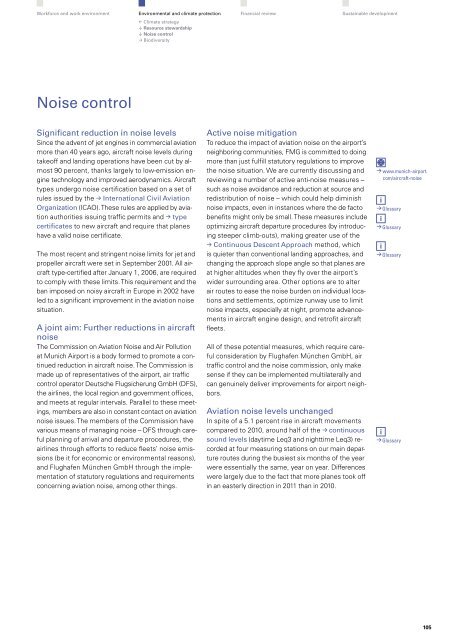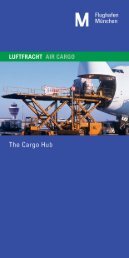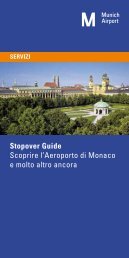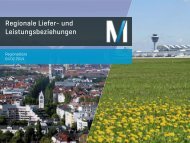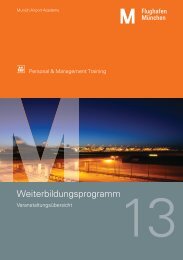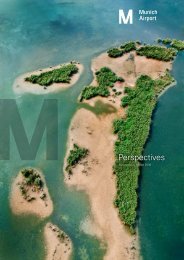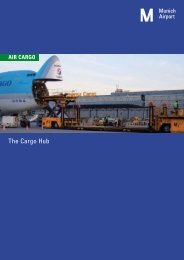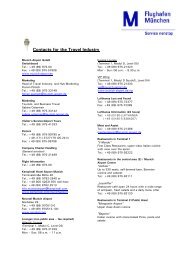"Perspectives 2011" - Sustainability and Annual Report (pdf)
"Perspectives 2011" - Sustainability and Annual Report (pdf)
"Perspectives 2011" - Sustainability and Annual Report (pdf)
Create successful ePaper yourself
Turn your PDF publications into a flip-book with our unique Google optimized e-Paper software.
Workforce <strong>and</strong> work environmentEnvironmental <strong>and</strong> climate protectionP Climate strategyq Resource stewardshipq Noise controlp BiodiversityFinancial reviewSustainable developmentNoise controlSignificant reduction in noise levelsSince the advent of jet engines in commercial aviationmore than 40 years ago, aircraft noise levels duringtakeoff <strong>and</strong> l<strong>and</strong>ing operations have been cut by al -most 90 percent, thanks largely to low-emission enginetechnology <strong>and</strong> improved aerodynamics. Aircrafttypes undergo noise certification based on a set ofrules issued by the ) International Civil AviationOrganization (ICAO). These rules are applied by aviationauthorities issuing traffic permits <strong>and</strong> ) typecertificates to new aircraft <strong>and</strong> require that planeshave a valid noise certificate.The most recent <strong>and</strong> stringent noise limits for jet <strong>and</strong>propeller aircraft were set in September 2001. All aircrafttype-certified after January 1, 2006, are requiredto comply with these limits. This requirement <strong>and</strong> theban imposed on noisy aircraft in Europe in 2002 haveled to a significant improvement in the aviation noisesituation.A joint aim: Further reductions in aircraftnoiseThe Commission on Aviation Noise <strong>and</strong> Air Pollutionat Munich Airport is a body formed to promote a con -tinued reduction in aircraft noise. The Commission ismade up of representatives of the airport, air trafficcontrol operator Deutsche Flugsicherung GmbH (DFS),the airlines, the local region <strong>and</strong> government offices,<strong>and</strong> meets at regular intervals. Parallel to these meetings,members are also in constant contact on aviationnoise issues. The members of the Commission havevarious means of managing noise – DFS through care -ful planning of arrival <strong>and</strong> departure procedures, theairlines through efforts to reduce fleets’ noise emissions(be it for economic or environmental reasons),<strong>and</strong> Flughafen München GmbH through the implementationof statutory regulations <strong>and</strong> requirementsconcerning aviation noise, among other things.Active noise mitigationTo reduce the impact of aviation noise on the airport’sneighboring communities, FMG is committed to doingmore than just fulfill statutory regulations to improvethe noise situation. We are currently discussing <strong>and</strong>reviewing a number of active anti-noise measures –such as noise avoidance <strong>and</strong> reduction at source <strong>and</strong>redistribution of noise – which could help diminishnoise impacts, even in instances where the de factobenefits might only be small. These measures includeoptimizing aircraft departure procedures (by introducingsteeper climb-outs), making greater use of the) Continuous Descent Approach method, whichis quieter than conventional l<strong>and</strong>ing approaches, <strong>and</strong>changing the approach slope angle so that planes areat higher altitudes when they fly over the airport’swider surrounding area. Other options are to alterair routes to ease the noise burden on individual locations<strong>and</strong> settlements, optimize runway use to limitnoise impacts, especially at night, promote advancementsin aircraft engine design, <strong>and</strong> retrofit aircraftfleets.All of these potential measures, which require carefulconsideration by Flughafen München GmbH, airtraffic control <strong>and</strong> the noise commission, only makesense if they can be implemented multilaterally <strong>and</strong>can genuinely deliver improvements for airport neighbors.Aviation noise levels unchangedIn spite of a 5.1 percent rise in aircraft movementscompared to 2010, around half of the ) continuoussound levels (daytime Leq3 <strong>and</strong> night time Leq3) recordedat four measuring stations on our main departureroutes during the busiest six months of the yearwere essentially the same, year on year. Differenceswere largely due to the fact that more planes took offin an easterly direction in 2011 than in 2010.) www.munich-airport.com/aircraft-noise) Glossary) Glossary) Glossary) Glossary105


